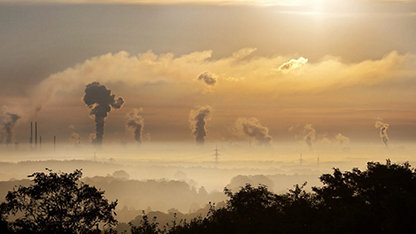Trees and woodlands are now seen as a critical part of the carbon solution, whilst at the same time increasing biodiversity and enhancing important landscapes.
Woodland Carbon – the emerging opportunity
Trees and Carbon Capture are often seen as marching hand in hand. However, for many in the sector, the ability to develop a structure that will see realistic values attached to woodland carbon, has meant historically that many projects have floundered in the planning with only a relatively small number of pioneering landowners taking up the challenge.
However, the tide may be turning and in a recent article for the forestry press, Dr Vicky West, who heads up the Forestry Commission's woodland carbon team, reported that some of the early projects are now showing real results with actual verified carbon units being traded in the UK market. We have also seen the Government's £50 million commitment to support the development of a domestic woodland carbon market, through the emerging Woodland Carbon Guarantee scheme. Details are still being established, but we are likely to see these come forward later this summer.
In the last few weeks we have also seen calls from the Committee on Climate Change, for the UK to plant 3 billion trees and 200 miles of hedgerows by 2050. Trees and woodlands are now seen as a critical part of the carbon solution, whilst at the same time increasing biodiversity and enhancing important landscapes.
The Woodland Carbon Code
The Woodland Carbon Code (WCC) is the UK standard for forestry projects for mitigation of climate change. It provides independent verification and validation and assurance about the levels of carbon sequestration from managed woodlands and their contribution to climate change mitigation.
Every WCC project appears on the UK Register of Woodland Carbon Projects, provided by the international registration agency Markit. The registry contains project information and documentation, as well as the facility to list, track ownership and retire ("use") carbon units. Projects and their documentation are independently validated at the outset and at regular intervals throughout the projects' life. An overall "Buffer" account is also maintained to cover losses from e.g. fire, pest or disease outbreaks, with contributions taken from each project on a risk-assessed basis.
To date, some 190 projects have been validated or brought forward by a diverse range of project developers including The Woodland Trust, Forest Carbon, local authorities and processers. Acting on behalf of individual owners Lockhart Garratt have brought forward over a dozen projects including some group schemes through cooperation with engaged landowners.
Together, these projects have created over 20,000ha of woodland which are predicted to sequester 6.3m tonnes of carbon dioxide equivalent (tCO2e) from the atmosphere over their lifetime of up to 100 years.
This 63,000 tCO2e per year needs to be compared to the UK's (current) annual emissions of 468m tCO2e per year. Whilst new woodlands are never going to compensate for the UK's current level of emissions, they are a very important part of the picture as the Government moves towards its commitment to net zero emissions. This is before we even consider the many additional benefits to biodiversity, landscape and quality of life that our woodlands provide.
Volumes of Carbon
Obviously the amount of carbon that is actually sequestered by new woodland will depend on a host of factors, not least species, site selection and management. However, as noted above the 20,000ha of woodland already registered are anticipated to sequester an average of 315 tCO2e/ha over their lifetime. On this basis a woodland area of 10ha would lock up some 3,150 tCO2e.
Current Markets
The current market is split between the sale of projected and actual units of sequested carbon within the growing crop. The unit of sale are currently:-
- Pending Issuance Units (PIUs) – these relate to estimates of future carbon sequestration and have formed the majority of the market to-date, principally providing funding to support woodland establishment on the back of Corporate Social Responsibility (CSR) driven investment.
- Woodland Carbon Units (WCUs) – these relate to actual carbon sequestered following a verification process
Current market values are in the range of £5 – 10 tCO2e. However, to date this market has been dominated by PIUs and it is not yet clear if WCUs that represent actual sequestered carbon will attract a higher figure.
In addition the above values are in advance of the third party costs of verification and validation of any project. It is not therefore surprising that this is not setting the forestry world alight. However, the current policy context under Defra's 25 year Environment Plan, the UK Clean Growth Strategy and the mandatory reporting of greenhouse gas emissions do provide a framework for potential market development and change.
Market Aspirations
The Government's aspiration to seek the development of the domestic carbon market has been highlighted through the commitment set out in the 2018 autumn statement to offer a "Woodland Carbon Guarantee" for WCUs with £50million to be committed over the next 30years. The details of this scheme are still awaited but likely to be announced later this summer.
However, traded market values are still a long way short of the Government's non-traded Carbon Values which many argue better reflect the "real" value of carbon if it were to be exchanged. The Department of Business, Energy and Industrial Strategy guidance uses a 2018 non-traded price of £67/tCO2e as against a traded value of £5/tCO2e. This is then projected to rise to £156 tCO2e for both traded and non-traded by 2040.
The expectation therefore is that there is the opportunity to secure an asset of real commercial value as carbon continues to increase in importance.
Summary
The Woodland Carbon Code and the associated Markit registration and verification process provide a robust mechanism that is now delivering real Woodland Carbon Units: this in conjunction with the massive Government focus on carbon and the role of new woodlands presents a really tangible and marketable opportunity.
Whilst current tradeable values will not deliver the change required, this is recognised by Government and the prospect of a move to values that reflect the "real" value to society could really put woodlands at the heart of the delivery of real and tangible public goods.
- Article by John Lockhart, member of RICS' Rural Board















